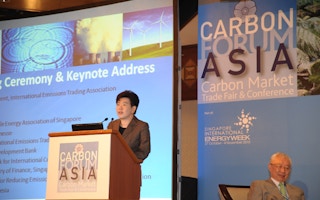Regulatory hurdles remain the most visible challenge for the carbon trading industry and the pace of certifying these projects is too slow, say carbon industry experts.
The process of developing carbon credit projects have become so bureaucratic that it may hinder the growth of the carbon industry, and policy reform is urgently needed to address the issues, they added.
Carbon credit projects are certified and audited by the United Nations under its Clean Development Mechanism (CDM) scheme which enables the project to generate carbon credits to sell on carbon markets.
Experts say it used to take at most four months to register a CDM project and verify their carbon reductions respectively.
“Today, the end-to-end process of timelines has doubled, tripled, and even quadrupled,” said Leo Perkowski, Director of AES Corporation & AgCert International. Due to the increased layers of red tape in recent years, he has seen CDM project submissions sitting in a three-and-a-half months queue before being touched.
He was speaking at the Carbon Forum Asia, an annual event bringing carbon industry experts to Singapore.
Several speakers agreed that CDM developers are faced with long-drawn-out qualifying processes, irregularities of standard of evaluation and the absence of direct communication for individual projects.
Such lack of stability and transparency from the CDM Executive Board often leave project developers exasperated and clueless why their projects were rejected.
“It clearly delays our decision-making,” said Lim Ming-Yee of Shell International Eastern Trading Company, who works as an Environmental Products Originator. Shell participates in the CDM industry by purchasing carbon offsets to fulfil its emission compliance requirement
Unfortunately, the protracted process of evaluation creates unnecessary difficulties for companies, she said. It cripples not only the progress of their projects development, but also their investors’ confidence in them.
Other speakers at the conference yesterday called for a reform of CDM policies. Some suggestions included standardising expectations of project evaluation, improving direct communication between the project participants and the Executive Board, and the provision of training to those involved in the process.
Advisor on Climate Change with the Asian Development Bank, Lu Xuedu, said he was not holding out hope for an expeditious reform.
The former vice chair of the CDM Executive Board noted that decision-making is slow as there is no sole decision-maker in the Executive Board. “It’s normal for members to have different views or issues and have intense debates among them,” said Mr Lu.
He also pointed out that red tape cannot be reduced or removed overnight in the real world. Bureaucracy is the quintessence of big organisations, and the UN that mandates CDM is no exception to this rule, he said.
In contrast, he believes in empowering CDM project developers with “the power to appeal” against decisions made by the Executive Board”. “These players have the responsibility but not the power,” he said.
But the onus to improve lies not only on the Executive Board. “Certainly, project participants do need to improve the quality of their work,” said Mr Perkowski, who works closely with CDM project developers- expressing a sentiment shared by other delegates.
“But I don’t believe they should be penalised for typos and small mistakes (in their proposals or reports), which is sometimes unavoidable when English is their second-language,” he continued.
In spite of its administrative shortcomings, CDM has its merits that make it a widely supported emission reduction tool, he conceded.
For one thing, the CDM scheme has helped generate global awareness on climate change as compared to a decade ago, and it encourages the transfer of finance and technology from rich to poorer countries, he said.
“Any good mechanism needs good stability, better clarity and predictability to move forward,” added Ms Lim. “These are issues that the Executive Board has to solve for sure.”










